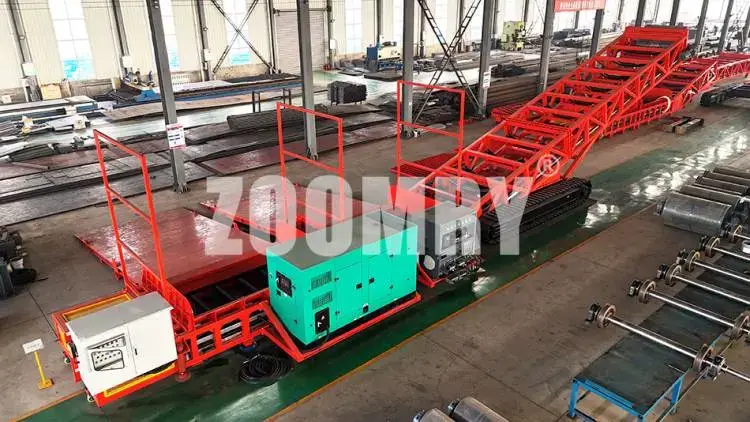Time:2025-04-27 15:40:34 Number of Clicks:
With global bulk commodity trade exceeding 12.8 billion tons (UNCTAD 2023 data), ports, mines, and construction sites face unprecedented efficiency challenges. As core equipment in bulk material handling, the coordinated operation of mobile shiploaders and truck unloading systems directly determines supply chain cost competitiveness. During a port expansion project, Zoomry Heavy Industries found that 65% of customers face decision-making dilemmas when choosing between tracked and wheeled unloaders—a choice impacting not only initial procurement costs but also operational efficiency over the next decade.

Tracked truck unloaders feature all-welded steel chassis + dual-variable hydraulic pump systems. For example, Zoomry's ZRLD-TU1800 achieves ground pressure as low as 0.55 kg/cm²—equivalent to an adult standing on one foot—compared to 7.2 kg/cm² for wheeled models like the ZRLS-TU1400, giving tracked units significant advantage in muddy terrain.
Power configurations differ: tracked models use 162 kW diesel engines to drive hydraulic systems, while wheeled models employ 75 kW motors + gearboxes. Field tests show tracked units consume 18% more fuel during 8-hour continuous operation but achieve 40% higher effective working time in complex terrain.
At Saudi Arabia's Dammam Port, wheeled unloaders demonstrated remarkable agility—transferring from truck unloading to shiploader docking in just 7 minutes, 3x faster than tracked units. However, on Vale's 25° slopes in Brazil, tracked models maintained stable output at 1,800 t/h, while wheeled units maxed out at 12° inclines.
| Metric | ZRLD-TU1800 (Tracked) | ZRLS-TU1400 (Wheeled) |
|---|---|---|
| Max Slope Ability | 25° | 12° |
| Min Turning Radius | 3.8m | 7.2m |
| Transfer Speed | 0.8 km/h | 15 km/h |
| Ground Pressure | 0.55 kg/cm² | 7.2 kg/cm² |
For inquiries about tracked vs. wheeled truck unloaders, contact us:
Tracked models' split suspension systems automatically adjust pressure distribution across 5 bogie wheels, increasing tilt tolerance to ±8°—60% better than conventional designs. Wheeled units exhibit 15% tire slippage even with steel plate assistance.
In 30-day field tests, tracked unloaders achieved 98.7% uptime, processing 523,800 tons. Wheeled units matched daily peaks but required 2-hour daily tire cooling, reducing monthly throughput by 12%.
Track links require replacement every 5,000 hours ($3,800 per service), while wheeled units need full tire sets every 3,000 hours ($8,500). However, tracked drive wheel bearings demand 35% more labor hours.
Zoomry's tracked unloaders with smart balancing systems reduced tilt risks by 83% during mine downpours. Wheeled units cut blowout rates from 1.2 to 0.3 incidents/1,000 hours via TPMS.
Tracked models with triple-filter hydraulics leaked just 0.08 ml/h—91% less than standard systems. Electric wheeled units emitted 62% less CO₂ per ton processed vs. diesel.
At Australia's Hedland Port, tracked unloaders paired with mobile shiploaders created a "direct-loading" system boosting efficiency by 27%. Wheeled units deployed with telescopic stackers in Vietnam's cement plants required only 72 hours for setup.
A 3D model based on ground hardness, material flowability, and daily throughput:
Copyright © 2002-2024 Zoomry Group Company Limited